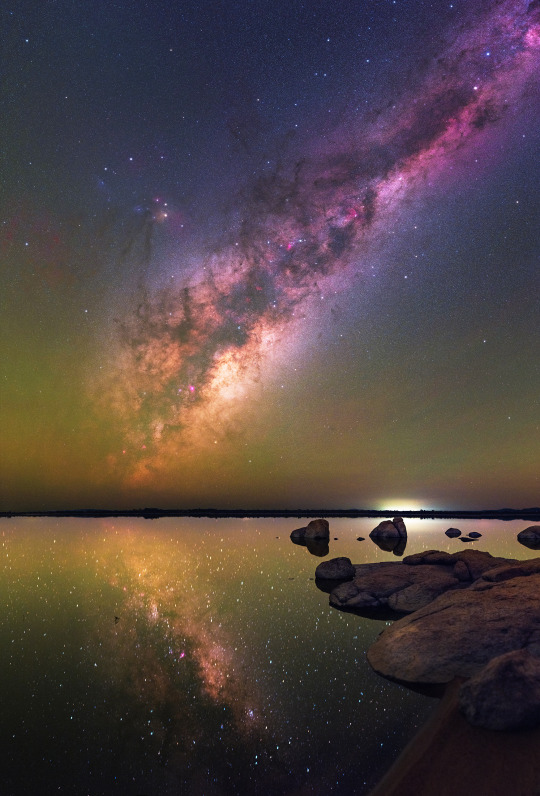Text

Fading Ice over Seven Mars Years
This is the latest of a series of images to monitor ice exposed by a new impact crater that formed before 2012. The bright and relatively blue patches have continuously shrunk over time, and today there is only a small area inside the crater that is slightly brighter and bluer than the typical dusty Mars surface.
A closeup shows three prior images, all acquired in the same season (middle northern spring). Note that HiRISE images are stretched according to the scene brightness range, so the earlier images have much darker surrounding areas because the exposed ice is so bright.
The ice fades over time as the water ice sublimates into the atmosphere during warm seasons, aided by dust that settles out from the atmosphere to cover the ice. There must still be abundant clean water ice throughout this area only centimeters or inches below the dust cover.
ID: ESP_087476_2240 date: 25 March 2025 altitude: 303 km
NASA/JPL-Caltech/University of Arizona
47 notes
·
View notes
Text
South Island Sediments

In April and May late autumn storms ripped through Aotearoa New Zealand. This image shows the central portion of South Island, where coastal waters are unusually bright thanks to suspended sediment. (Image credit: W. Liang; via NASA Earth Observatory) Read the full article
47 notes
·
View notes
Text

A Diversity of Dunes in Renaudot Crater
Renaudot is a 64-kilometer diameter impact crater located on the border of Utopia and Terra Sabaea, Mars. It contains a variety of dunes that vary in size, shape, and composition.
Both dark and light-toned dunes are located on the floor of this crater. The dark-toned dunes are likely basaltic sand while the light-toned dunes source from other materials. The floor underlying the dunes is an eroded lighter-toned surface consisting of rougher, angular blocky material or cracked, cemented surface materials.
It is likely that the sources for these dunes are outside of the crater and sediment was blown in by prevailing winds. Windward-facing dune slopes tend to have lower slopes while those pointing in the downwind direction are steeper. This suggests that the windward direction for the basaltic and larger light-toned dunes is generally towards the south, although there are smaller sets of differently aligned dunes suggesting varying wind directions.
ID: ESP_085411_2225 date: 15 October 2024 altitude: 297 km
NASA/JPL-Caltech/University of Arizona
73 notes
·
View notes
Photo



Nitrogen in Steel
Often considered an essential alloying element, nitrogen is present in all steels simply as a result of the manufacturing process. Though nitrogen can be harmful to the properties of steel in the wrong form, enough research has been conducted to ensure that steelmakers utilize nitrogen’s effects in beneficial ways. It is not typically necessary to add in excess nitrogen, but when it is added it can be in the form of gaseous nitrogen or nitrogen containing alloys such as ferromanganese.
The effects of nitrogen in steel are difficult to generalize because of the varying other elements that might interact with it. Elements such as titanium, niobium, or vanadium are nitride forming elements which each react differently - vanadium nitrides can precipitate during hot deformation and control austenite recrystallization but titanium nitrides are insoluble, precipitating at temperatures even higher than typical hot working ranges. Aside from controlling austenite grain size, nitrogen is also capable of contributing to precipitation strengthening.
When not properly managed, the possible negative affects of nitrogen include a decrease in ductility and formability. Nitrogen steels are typically more difficult to cold work than other steels and the presence of nitrogen contributes to strain aging in flat-rolled carbon steels.
Nitriding is also an important process for many steels, and involves the diffusion of nitrogen into finished surfaces to create much higher case hardnesses. By itself, nitrogen in an interstitial alloying element. It can also improve corrosion resistance, specifically localized corrosion such as pitting or intergranular corrosion. Nitrogen is more often used in high alloy (austenitic) steels than low alloys steels, sometimes considered to be a substitute for nickel.
Sources/Further Reading: ( 1 ) ( 2 - image 1 ) ( 3 ) ( 4 - image 2 ) ( 5 )
44 notes
·
View notes
Photo

Milky Way at Lake Norring, Western Australia
Nikon d810a - 50mm - ISO 6400 - f/3.2 - Foreground: 5 x 30 seconds - Sky: 12 x 30 seconds - iOptron SkyTracker - Hoya Red Intensifier filter
3K notes
·
View notes
Text

This curious geometry consists of a base chord, a point interiror to the chord, three half circles, and four vertices that always form a rectangle, no matter where the interior point lies. The four points are two vertical points and two points of common tangency.
53 notes
·
View notes
Text
Bow Shock Instability

There are few flows more violent than planetary re-entry. Crossing a shock wave is always violent; it forces a sudden jump in density, temperature, and pressure. But at re-entry speeds this shock wave is so strong the density can jump by a factor of 13 or more, and the temperature increase is high enough that it literally rips air molecules apart into plasma. (Image credit: A. Álvarez and A. Lozano-Duran) Read the full article
109 notes
·
View notes
Text

To celebrate its third anniversary of science operations, astronomers used the telescope to examine a singular “toe bean” of the Cat’s Paw Nebula, a massive star-forming region located about 4,000 light-years away. Webb reveals a subset of mini toe bean-reminiscent structures composed of gas, dust, and young stars in near-infrared light.
The young stars are carving the surrounding gas and dust, creating caverns that showcase the bright starlight represented in blue. This scene is temporary—the young stars will eventually shut down the local star formation process: http://webbtelescope.pub/4khJK9T
96 notes
·
View notes
Text
Glimpses of Coronal Rain

Despite its incredible heat, our sun’s corona is so faint compared to the rest of the star that we can rarely make it out except during a total solar eclipse. But a new adaptive optic technique has given us coronal images with unprecedented detail. (Image credit: Schmidt et al./NJIT/NSO/AURA/NSF; research credit: D. Schmidt et al.; via Gizmodo) Read the full article
86 notes
·
View notes
Text

A Fissure and Channel near Pavonis Mons
This image shows striking features. A linear trough strikes northeast, then abruptly ends (or changes into a narrow ridge). Where the trough ends, a sinuous channel has an east-southeast strike, trending at almost a right angle to the trough. What happened to form these features?
We can speculate that first there was a southwest-to-northeast trending fracture or fault, perhaps associated with a volcanic vent. Groundwater (or some other runny fluid) coursed through the fault until overflowing and forming the sinuous channel. Continued movement through the fault carved a trough up to the overflow point.
Be sure to look at the stereo anaglyph through red-blue glasses.
ID: ESP_086934_1775 date: 11 February 2025 altitude: 257 km
NASA/JPL-Caltech/University of Arizona
54 notes
·
View notes
Photo

2025 July 11
The Veins of Heaven Image Credit & Copyright: P-M Hedén (Clear Skies, TWAN)
Explanation: Transfusing sunlight as the sky grew darker, this exceptional display of noctilucent clouds was captured on July 10, reflected in the calm waters of Vallentuna Lake near Stockholm, Sweden. From the edge of space, about 80 kilometers above Earth’s surface, the icy clouds themselves still reflect sunlight, even though the Sun is below the horizon as seen from the ground. Usually spotted at high latitudes in summer months, the night shining clouds have made a strong showing so far during the short northern summer nights. Also known as polar mesopheric clouds they are understood to form as water vapor driven into the cold upper atmosphere condenses on the fine dust particles supplied by disintegrating meteors or volcanic ash.
∞ Source: apod.nasa.gov/apod/ap250711.html
67 notes
·
View notes
Text

A strip of paper of width a is folded as shown. How short can the crease be?
25 notes
·
View notes
Text
Bright Night Lights

A coronal mass ejection from the Sun set night skies ablaze in mid-October 2024. This composite panorama shows a busy night sky over New Zealand’s South Island. (Image credit: T. McDonald; via APOD) Read the full article
63 notes
·
View notes
Text


Ridges in Nilosyrtis Mensae
The presence of different ridge populations, varying in shape, distribution, stratigraphic position, and surface texture, offers an opportunity to understand the evolution of the landscape, which serves as a representative model for the broader region.
ID: ESP_088312_2135 date: 29 May 2025 altitude: 293 km
NASA/JPL-Caltech/University of Arizona
63 notes
·
View notes




